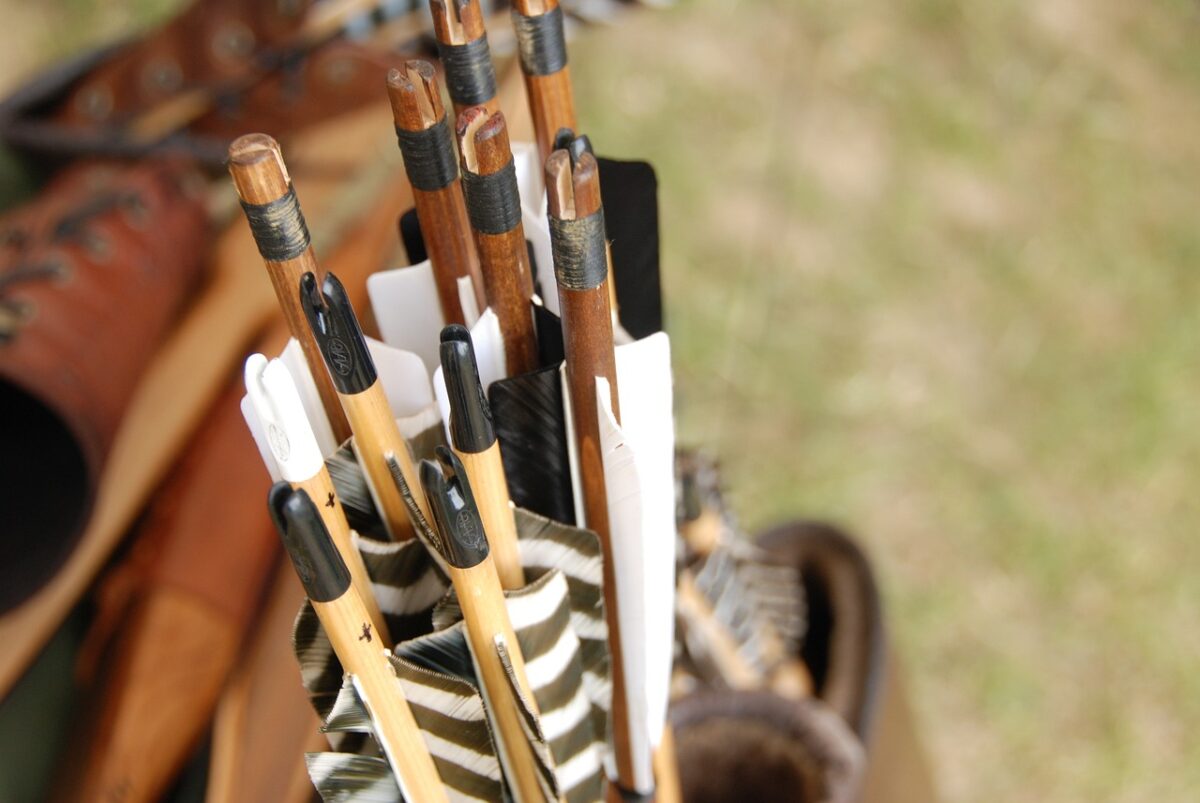Cutting carbon arrows can be frustrating for archers of all experience levels. Without the proper tools, it is easy to end up with uneven edges. This article provides expert-recommended solutions using accessible alternatives to a dedicated arrow saw.
With years of experience in archery equipment and technique, I understand the importance of precise arrow slicing and how difficult it can be to achieve with improvised tools. I have tested numerous methods in my practice to find out how to cut carbon arrows without a saw.
Contents
How to Cut Carbon Arrows Without a Saw
A pipe cutter, an electric knife sharpener, a rotary tool like a Dremel, and a grinder are some of the non-saw cutting tools you can use to cut carbon arrows. With these common household tools, you can get clean, accurate cuts without specialized saws.
Follow our guide to becoming an arrow-slicing master. Whether you are gearing up for archery season or shooting competitively, accurately cutting your graphite arrows saves money while improving accuracy.

Using Pipe Cutters
Arrows flying true depends on their precise construction. Designed for cutting plumbing pipes, these compact roller cutters are another handy carbon arrow-slicing tool.
The cutting wheel bearing down as your turn the cutter produces accurate, straight finishes. Here is how to put pipe cutters to work on arrows:
- Select the correct size pipe cutters. You will need cutters slightly larger than the arrow shaft diameter.
- Open the handles of the pipe cutters fully and place an arrow through the mouth of the cutters.
- Close the handles of the cutters until they grip the arrow shaft. Do not apply too much pressure yet.
- While holding the cutters in place on the arrow, turn the cutters slowly to align the cutting wheel with your desired cut location.
- Continue turning the cutters while gradually applying more pressure until the arrow shaft is cut through. Do not force the cutters.
- Remove the two arrow pieces and deburr the cut edges with sandpaper or a metal file. This will remove any sharp or jagged edges.
- Test fit the arrow points, and arrow ends on the cut arrows to ensure a secure fit. You may need to recut or re-deburr the arrows if the ends do not fit properly.
- Secure the arrow points and ends to the shaft. Allow sufficient time for the adhesive to cure before using the arrows.
It takes finesse, yet pipe cutters are precision carbon arrow-cutting machines.
Using an Electric Knife Sharpener
Knife sharpeners with abrasive whetstones hone blades—and can also grind carbon arrow shafts to an exact length. Here is how you trim graphite arrows with an electric sharpener:
- Only use an arrow-specific knife sharpener. Standard sharpeners may damage the arrow shafts.
- Secure the arrow in a vise or clamp. The arrow must remain still during sharpening to avoid damage.
- Start on the lowest speed setting and work up gradually. Higher speeds can cause splintering.
- Apply steady pressure as you run the arrow through the sharpener plates. Go slow.
- Only sharpen enough to slice the arrow shaft. Over-sharpening can grind off too much carbon and weaken the arrow.
- Deburr the cut ends with sandpaper to smooth any sharp edges.
- Gently wipe the cut ends with acetone or alcohol to remove carbon dust. Let it dry thoroughly before assembly.
- Inspect the cut ends for defects or cracks.
- Apply adhesive to arrow inserts and components as needed.
It takes care and patience, yet sharpeners can achieve professional-grade arrow cuts.

Using a Rotary Tool
A rotary tool is a handheld electric tool that can be used for a variety of tasks, including cutting thick plastic, cutting a hockey stick, or graphite arrows. The following steps will guide you on how to cut them:
- Select the correct rotary tool attachment. A cut-off wheel or abrasive cut-off disc works best.
- Secure the carbon arrow in a vise or other fixture. The arrow must remain still during cutting.
- Attach the cut-off wheel or disc to the rotary tool collet and tighten it securely.
- Turn on the rotary tool at medium speed and hold the tool perpendicular to the axis of the arrow.
- Lower the cutting attachment to the arrow and gently apply downward pressure. Allow the abrasive wheel to slowly work through the carbon arrow shaft.
- Continue lowering and rotating the cut-off wheel until it slices through the arrow. Move the tool in a straight line along your desired cut location.
- Once cut through, turn off the rotary tool and remove the arrow pieces from the fixture.
- Use a file or sandpaper to smooth and deburr the cut ends. Sanding is important in any DIY project like cutting a laminate flooring lengthwise or cutting a wooden dowel without a saw to achieve a polished result.
- Clean the cut ends with acetone or alcohol to remove carbon dust. Let dry completely.
Using a Grinder
You can use a grinder with a dedicated disc that is thinner and made of resin-bonded diamonds, which cut cleanly without generating excess heat. It’s also ideal for cutting steel if you don’t have a saw. Here are the basic steps to cut graphite arrows using a grinder:
- Mark the arrows. Use a waterproof marker to mark where you want to cut each arrow. Be very precise with your marks.
- Secure the arrow. Clamp or brace the arrow securely so it does not move during cutting. Make sure it is well supported on both sides of the cut line.
- Choose the right grinding disc. Use a thin resin-bond diamond blade grinding disc to cut composites like carbon fiber. Regular abrasive discs can clog or damage the material.
- Cut slowly. Apply gentle, even pressure as you cut.
- Go slow and take your time. No need to force the blade. Let the diamond grit do the work.
- Cool with water. Use a spray bottle to mist water on the cutting site continuously. This keeps the carbon fibers from overheating and prevents damage.
- Clean up edges. Once cut, use sandpaper to clean and smooth any rough or frayed edges. A file can also help refine the cut surface.
- Inspect for cracks. Inspect the cut ends under bright light for hairline cracks in the carbon weave from heat or excess pressure. Scrape or recut as needed.

What Are Safety Essentials When Cutting Carbon Arrows
Household tools work on graphite arrows when used with caution and the proper approach. Whichever improvised arrow saw you choose, safety comes first. Follow these essential precautions:
- Wear eye protection. Carbon splinters and debris fly rapidly.
- Use dust masks and gloves since carbon fibers are harmful if inhaled or embedded in the skin.
- Never cut beyond an arrow insert or towards your hand.
- Make small, gradual cuts rather than forcing tools through the shaft.
- Frequently lubricate tools and arrow components to prevent overheating.
- Ensure adequate workspace and clamp materials for maximum control.
Related Questions
What Can I Cut Carbon Arrows With?
Carbon arrows can be cut using various tools depending on the specific materials and construction of the arrow. Some good options are an arrow saw, a specialized tool designed specifically for cutting arrows, a Dremel tool, a miter saw, an angle grinder, and a pipe cutter.
Can You Cut Carbon Arrows With a Hacksaw?
Yes, a hacksaw can cut graphite arrows to the desired length, allowing you to customize them for your needs. However, it is important to take certain precautions to ensure a clean and safe cut.
Can You Cut Arrows Yourself?
Yes, it is possible to cut arrows yourself, including graphite arrows. Cutting arrows allows you to customize their length to suit your needs and preferences. However, it is important to exercise caution and follow proper techniques to ensure a clean and safe cut.
Conclusion
While cutting carbon arrows without a saw may seem challenging, it’s possible to do it securely using the correct methods. No matter if you are using a pipe cutter or other tool, it is critical to pay attention to the instructions and take your time to prevent errors.

